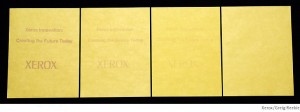As far as consumers are concerned, before Amazon’s Kindle arrived, the last time printing had been considered high technology had been around 15th century, the time of Johannes Gutenberg. Today people seem to be reading mostly from screens, be it mobile, desktop or Kindle screens. Declining newspaper sales are merely the most visible reflection of a larger trend: the days when people read things on paper seem all but counted and digital is king.
That is, unless you happen to be in charge of your company’s printing operations. Gartner estimates that between 1% and 3% of an organization’s revenues are spent on print. Think about the last time you went to a meeting and needed to print out meeting notes for everyone to keep everybody on the same page—literally. And what happens to these notes after the meeting? Many of them end up in the trash bin. In fact, according to Xerox, 40% of documents that are printed in the office are only viewed once. That is a huge waste, not to mention that it’s environmentally unfriendly.
While Kindle and other electronic readers are surely useful for books and newspapers, people still prefer to read many documents from paper. This is a major reason why the promised revolution in corporate workflow where electronic documents (say, in the form of PDF files) would be created and shared without the need to print them out, despite much hype, has not materialized.
So instead of changing people to wean them off paper, some are trying to change the paper itself. Xerox for one has been working on what it calls “erasable paper”. A special printer would print on special paper, and the printed image would disappear by itself in 16—24 hours, or be erased immediately by heating it, after which the paper can be reused. Separately, a team from Northwestern University is working on plastic-sheet “paper” that allows printing in color and defining the time after which the image disappears.
Neither technology is yet available commercially and their prices are unknown, so the economics of their use compared to traditional paper cannot be estimated. But if and when these technologies come about, the need for shredders and dedicated paper recycling bins would fade away, much like the text on the erasable paper.
|


